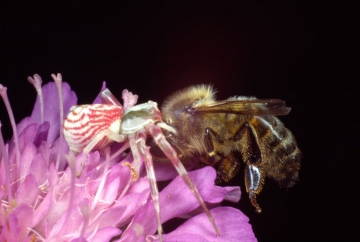Summary for Thomisus onustus (Araneae)
previous species | next species
National Distribution
Terms of Use. Double-click on map to go to region

Explore Regional Distribution
Please log on and add a note on this species
About this species
Recorded altitude range10m to 110m
Species text
DistributionThe species is restricted to central southern and south-east England. It is widespread in Europe, especially in the south.
Habitat and ecology
T. onustus occurs in dry or moderately wet, mainly mature, heathland, usually on flowers of Erica tetralix or E. cinerea, where it sits to ambush prey, mostly bees and large flies. Adult females can adjust their background colour to some extent in order to match that of the flower upon which they sit (Oxford & Gillespie 1998). Both sexes are adult in May and June, and females deposit their egg-sac in July spun up in flower heads of Erica.
Status
The spider is widespread in central southern England, and often abundant where found, but very local. It may have undergone a moderate decline in occupied 10 km squares post-1992.
Threats
The loss of heathland to agriculture, forestry, development and excessive burning.
Management and conservation
This species occurs mainly on mature heather, which should be maintained by rotational management to maintain the full range of seral stages of heather. Large fires are likely to be detrimental, although the young stages disperse readily and can start to colonise new areas about 5 years after fire.
Text based on Dawson, I.K., Harvey, P.R., Merrett, P. & Russell-Smith, A.R. (in prep.). References
Adult Season
Habitats
background methodology
Recorded management for locations with Thomisus onustus
Recorded substrate and hydrology for locations with Thomisus onustus
Images
please log on and upload a new image for this speciesSee also A-Z Species Index - A-Z Picture Index - previous species | next species








